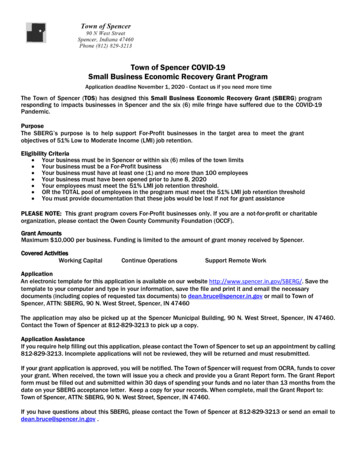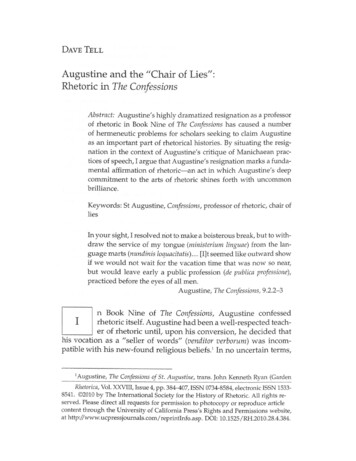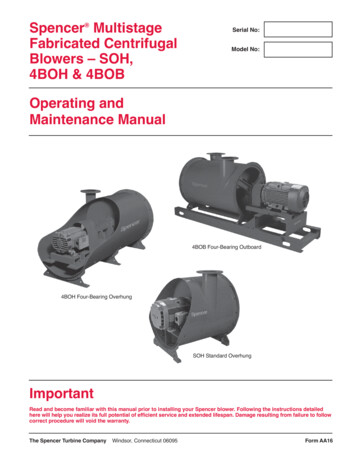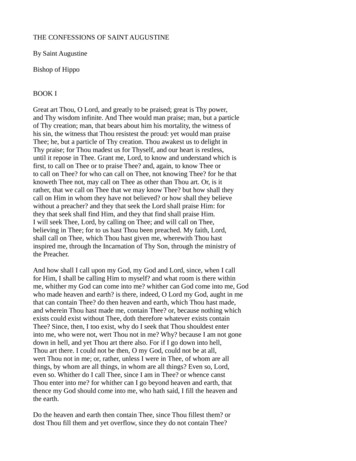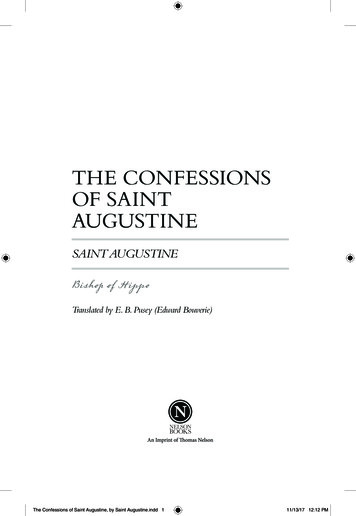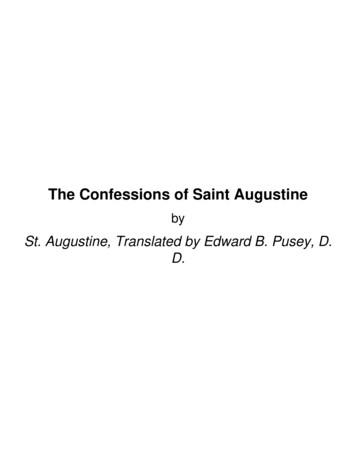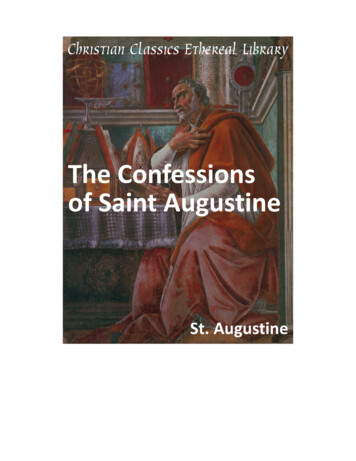
Transcription
Sadler and Sadler: Augustine Spencer27Augustine Spencer: NauvooGentile, Joseph Smith AntagonistRichard W. Sadler and Claudia S. SadlerDaniel Spencer Sr., his wife Chloe, and sons Daniel Jr., Orson, and Hiram Spencer and their families were devoted Nauvoo Mormons. However, inthe six months preceding Joseph Smith’s death, their eldest son, AugustineSpencer, who also lived in Nauvoo, but who remained aloof from the Church,turned antagonistic toward his family, became an outspoken critic against theChurch, and participated in the activities that led to Joseph Smith’s arrest anddeath at Carthage. How and why Augustine’s antagonism toward Mormonismdeveloped provides a historical case study that sheds light on the complexreligious, cultural, and social dynamics of nineteenth-century society and theSpencer family.The Daniel Sr. and Chloe Wilson Spencer FamilyDaniel Spencer Sr., born August 26, 1764, spent his early years in EastHaddam, Connecticut, on the Connecticut River. His ancestors had arrivedin Massachusetts during the first decade of the great Puritan migration of theRichard W. Sadler (Rsadler@Weber.Edu)is a professor of history and former dean of thecollege of Social and Behavioral Sciences at Weber State University. He received his BS,MS, and PhD degrees from the University of Utah. He specializes in nineteenth century UShistory. He is a fellow of the Utah State Historical Society, former editor of the Journal ofMormon History, past president of the Mormon History Association, and past chair of theUtah State Board of Education.Claudia Spencer Sadler (cldsadler@yahoo.com) received her undergraduate education atthe University of Utah and Weber State University. She is involved in family research andwriting, and is a great-great-granddaughter of Daniel Spencer Jr., a brother of AugustineSpencer, the subject of this article.The authors express appreciation to John and Debbie AuWerter, Joseph Johnstun, and GlenRowe for their assistance with the research conducted for this article.
28Mormon Historical Studies1630s. He served for a brief period in the American Revolution near the endof the war; then following the Revolution he moved north and west into thearea of the Berkshires in western Massachusetts, where he lived most of theremainder of his life as a blacksmith and farmer in the villages of Rockdaleand West Stockbridge. Many of Daniel Spencer’s cousins from the Connecticut area migrated at this same time to western Massachusetts and eastern NewYork for opportunity and land.In the West Stockbridge area, Daniel Sr. met Chloe Wilson (b. May 24,1765, Richmond, Massachusetts); they married on January 9, 1788 in WestStockbridge. From that union came eleven children: Augustine (1788-1864),Sophia (1791–1815), Theron (1792–1827), Daniel Jr. (1794–1868), Selecta(1796–1848), Hiram (1798–1846), Claudius Victor (1800–22), Orson (twin,1802–55), Alvira (twin, 1802–02), Chloe (1804–37), and Grove (1806–45).The Spencer family affiliated with the Baptist Church.1In 1776, the township of West Stockbridge consisted of five village settlements: West Center, West Stockbridge, Freedleyville, Rockdale, and Williamsville, with a total population of 370. Daniel Sr. settled in the West Stockbridge area as early as 1782 and was described as being five feet, six inchestall with dark hair and eyes.2The Williams River was a significant factor in the settlement of the area,as it provided water power for mills and forges. The river flows into theHousatonic River just north of Great Barrington and was often dammed fromcolonial times along its route to provide water power for mills and forges. TheShaker Mill Pond in West Stockbridge is an example of earlier impoundment.Consequently, besides farming, several industries developed and grew in thearea, including several forges, saw mills, fulling mills (a walk mill or a tuckmill), and grist mills. The area was rich in iron ore and marble, and both weremined very successfully. The marble business was so successful that a rail linewas built in 1838 connecting West Stockbridge with Hudson, New York, andthe Hudson River.Daniel and Chloe Spencer’s children grew up accustomed to village living, work, and education in the village school. All of the children were involved in the family farm, chores around the home, and the Rockdale ironforge. The great majority of Massachusetts families farmed the land for theirprimary source of income and sustenance. New Englanders worked their landwith oxen, which were surefooted on rocky slopes. In general, fathers hadboth legal and customary claims on their children’s labor until they reachedmaturity at the age of twenty-one.3Daniel involved all of his sons in farming, but only Hiram and Grovetook up the vocation. School attendance was not compulsory, yet most parentswanted their children to receive the basics of reading, writing, and arithmetic.
Sadler and Sadler: Augustine Spencer29Most children who were old enough to do serious work received their education in the winter months. The Spencer children attended the WilliamsvilleSchool located one mile south of their Rockdale home.The economy was very much barter and trade, and many farmers and artisans kept account books which gave transactions a precise monetary value.Exchanges, along with blood and religion, linked neighborhoods together. Nonational or state paper money existed prior to the Civil War, and a varietyof hard money (often foreign specie), both gold and silver, circulated in thecountry. Trading, swapping, and sharp bargaining became a part of life. Somebecame proficient, and others were taken advantage of.Daniel and Chloe’s first son, Augustine (sometimes called Augustin,Gust, Gustin, Augustas, and Auggie, but most often Augustine) would outliveall his brothers and sisters, with the exception of his brother Daniel Jr. Duringhis early teens, Augustine began working for others, returning home in theevenings and weekends to work for his father, who, unable to do heavy farmlabor, left much of the work to Augustine and his brothers.In 1814, as the War of 1812 moved into its third year, Augustine andTheron responded to a call of the governor of Massachusetts to assist in suppressing a threatened invasion by the British. They volunteered at Lee, Massachusetts, to serve in the Boston area in the company under the command ofCaptain J. Nye from the middle of September until the end of October.4 TheBritish threat in New England was stymied at Lake Champlain.In the years following the War of 1812, and as the nation enjoyed peaceand growth, the Spencer brothers were engaged in growth and developmentindividually and collectively. Each sought to gain material wealth as they matured along with the nation. Daniel Jr., a freighter, merchant, and investor, wasthe most economically successful of the Spencer brothers, and he often helpedfinance the other brothers in their ventures. Orson received more formal education than most of his siblings, and after attending the village school, LenoxAcademy, Union College in New York, and Hamilton Theological Seminary,became a successful Baptist minister.5 Hiram seemed generally content tofarm and stay close to his father in his farming ventures. Another brother,Claudius Victor, lived a short twenty-two years before he died in 1822; hissister Sophia died in 1815 at age twenty-four.Augustine, the oldest brother, throughout his life never seemed to find hisoccupational calling. He struggled to make ends meet and seemed always tobe in the economic shadow of his more successful siblings. Augustine married Eliza Brown, a local West Stockbridge girl, in 1815. They lived in WestStockbridge among family members and raised eight children: Caroline Cordelia (b. 1817), Alvira (Alvina) Louisa Matilda (b. 1819), Angeline Elizabeth
30Mormon Historical Studies(b. 1821), Sarah (b. 1823), Daniel (b. 1824), Harriet (b. 1828), Julia (b. 1830),and Charles Boyington (b. 1832).6In the spring of 1816, Daniel Jr. planned an extensive trading trip, andto purchase trading goods for the trip he borrowed nearly 20,000 from hiscousin Joseph Cone. Daniel, who had been a successful trader, purchasedmore than 18,000 in goods for his trip. To support a similar trading trip forAugustine and his friend Briggs Hill, Daniel signed notes from other investorsfor up to 10,000. Augustine and Hill traveled to New York, where they beganto sell their goods. In the midst of this effort, Hill, who was a master mason,decided to lecture about masonry in Masonic lodges, leaving Augustine to sellon his own. Augustine barely made enough to pay Daniel back for his initialinvestment. Daniel had also hired his brothers Theron, Claudius, and Hiramto sell for him for the next several years. Augustine again tried selling in NewYork in the autumn of 1816 with financing from his brother Daniel, but wasnot very successful. Daniel continued to sell on his own in the North duringthe summer months, and in the South in the winter. 7Beginning in 1815, Augustine began to speculate in real estate. Daniel Jr.would become increasingly more successful in buying and trading goods, andAugustine must have believed that with the expansion of the nation and parcels of land changing hands he could also be successful in the real estate business. On January 11, 1815, Augustine, in partnership with his brother Theron,purchased about twenty acres of land, one-quarter interest in a saw mill, andone-half interest in a mill yard located on the Williams River. This entire purchase, which came to five hundred dollars, was from Thomas Benedict, aWest Stockbridge resident.8 With the growth of industry and other businessesin West Stockbridge, trading and investment in real estate became an important part of the economy of the Berkshire district.On June 22, 1822, Augustine is listed as a trader in the land transactionthat takes place that day in which he agreed to purchase a lot called the Shakers Lot located in West Stockbridge from Thomas Patten and Freeman Stanleyof Tyringham, who sold the lot on behalf of the Community of TyringhamShakers to Augustine for fifty dollars. This lot of land in West Stockbridgewas located in the middle of the village on the main street and next door to theinn run by Sybil Griffith, sister of Sopronia Pomeroy Spencer, wife of DanielJr. Augustine built a building on the Shaker Lot and in partnership with hisbrother Daniel established a trading store and mercantile business. Over thesummer of 1822, both Augustine and Daniel worked in the store. Augustinewas unable to manage the store in such a way to meet his monetary obligations to the Shakers, and on September 7, 1822, the property reverted to theShakers. Daniel Jr. took over the contract with the Shakers in September of1822 for 80.25, and over the next two months was able to turn a profit with
Sadler and Sadler: Augustine Spencer31the store. By November 5, 1822, Daniel was able to fully pay the Shakers andtook over the store.9 Some suspicion came about in the village concerning Augustine’s ethics in relationship to this and other land transactions. Daniel tooexpressed his discontent with Augustine’s business practices and ethics.10In the 1825 West Stockbridge tax records, Hiram Spencer was listed ashaving one-half of the farm from the Burghart’s family, the John Sink houseand lot, two oxen, two cows, four horses, and two hundred pounds of swine.Daniel Jr. was listed as having seven acres of land and one cow. Daniel Jr. islisted as in partnership with his brother Theron in a mercantile store. Danielalso had sheds valued at 600, which could be a warehouse, and stock in tradevalued at 500. Augustine is not listed on the 1825 tax valuation.11In 1826, Augustine’s youngest brother, Grove Spencer, moved from WestStockbridge to Ypsilanti, Michigan, where he became a successful farmer,lawyer, and politician.12 Noting the success of Grove in Michigan, Theronmoved to the Ypsilanti area, where he settled and purchased property. In November of 1827, Theron returned to West Stockbridge, where he died suddenly on November 9, 1827. Upon his death, Theron’s property went to hisfather, Daniel Sr., who sold Theron’s Michigan property to Grove. More thana decade later, Augustine moved to Michigan and purchased some of Grove’sand Theron’s property.13In 1834, more than a half century after the fighting of the RevolutionaryWar ceased, Daniel Spencer Sr. applied for a pension for fighting in that war.Nothing ever came of the petition, which solicited monetary help from boththe Senate and the House of Representatives of the United States, even thoughDaniel Sr. was in his seventieth year. Tax records for Augustine in 1837 and1839 indicate that he was worth between 500 (1837) and 800 (1839).Between 1822 and 1842, Daniel Spencer Jr. purchased real estate in theWest Stockbridge area totaling over 153,533 in value.14 Compared to hisbrothers, Daniel was very successful in business, while Orson was a prominent Baptist minister. In contrast, Augustine seemed to be unable to make anykind of a successful economic start or progress.On June 22, 1839, Augustine and Eliza’s daughter Alvira Louisa Matilda Spencer married Ashbel Childs in Lee, Massachusetts. Following thismarriage, Augustine, Eliza, and three remaining children moved to Ypsilanti,Michigan, and began to live near Augustine’s brother Grove. Augustine waslisted as a farmer in Ypsilanti in the 1840 census.15The Spencer Family’s Conversions to MormonismIn the fall of 1839, a Mormon missionary visited West Stockbridge, andDaniel Spencer Jr., who was president of the local school board and had ac-
32Mormon Historical Studiescess to the village school, permitted the missionary to speak there.16 Threeyears earlier, in 1836, Mormon missionaries Brigham Young and his brotherJoseph, had visited nearby Richmond, Massachusetts, where they convertedtheir cousins Phineas, Levi, and Willard Richards. In January 1840, StephenBurnham, another Mormon missionary, visited West Stockbridge and baptized Daniel Spencer Jr. a Latter-day Saint in the Williams River, which ranbehind Daniel’s two main street stores. Following Daniel’s baptism, DanielSr., his wife Chloe, and Daniel’s brother Hiram and his family were all baptized. The conversion of the Spencer family members led to the organizationof the Union and West Stockbridge branch of the Church on April 19, 1840,by Phineas Richards and Stephen Burnham. The branch, with thirty members,included the areas of West Stockbridge and Richmond. In addition, Daniel Jr.visited his brother Orson, a Baptist minister living in Middlefield, Massachusetts, where he assisted in the conversion of Orson and his family.17To answer the religious call of the gathering as well as to protect theirinvestments in western Massachusetts, the Spencer brothers—Daniel, Hiram,and Orson—carefully planned their relocation to the Mormon gathering placeof Nauvoo, Illinois. Orson and his family, leaving Massachusetts in the springof 1841, set the pattern for the others to follow, traveling by way of Albany,the Erie Canal, and Lake Erie, and arriving in Nauvoo on September 4, 1841.Using Daniel’s resources, they began to locate land for the rest of the familywho would come later. Although eager to move to Nauvoo, Daniel remainedlong enough in western Massachusetts to maximize the sale value for theirproperty and other goods. In the spring of 1842, Daniel and Hiram Spencerand their families left West Stockbridge for western Illinois. In Nauvoo, thethree Spencer brothers (Hiram, Daniel, and Orson) became much more closeknit economically, socially, and religiously. Although tied together as brothersbefore their conversion to Mormonism, after joining the Church they began toassume roles and responsibilities and had successes that each of them wouldnot have been able to accomplish alone. From 1842 until their deaths, theyworked together for their common good, which unity would cause problemsfor Augustine, when, beginning in 1843, with his own personal self-interestsin mind, he tried to maneuver within the family circle.18In Nauvoo, the three Spencer brothers became actively involved in theChurch and the Mormon community. They purchased property inside the city(and farming property outside the community), built substantial homes, andwere called to positions of leadership. Hiram was the least involved of thethree brothers in civic and religious affairs, although he was a faithful Churchmember. His main responsibilities were to oversee the family farm which thebrothers operated jointly in the Nauvoo countryside. Orson played the mostprominent role. Following the excommunication and departure of John C.
Sadler and Sadler: Augustine Spencer33Bennett from Nauvoo in May 1842, Orson became chancellor of the University of Nauvoo (which functioned more on paper than it did in reality). In November, he began a series of letters that would become important missionarytracts for the early Church, Spencer’s Letters. In the February 6, 1843 Nauvoo city elections, Orson, along with Daniel H. Wells, George A. Smith, andStephen Markham, was elected alderman. Still later, on December 2, 1843,Orson, along with Orson Hyde, Parley P. Pratt, Wilford Woodruff, and GeorgeA. Smith, received his temple endowment in Joseph Smith’s Red Brick Store.Three weeks later on December 23, 1843, Orson’s wife Catharine was anointed and initiated into the “quorum” (males and females who had received theirtemple endowment and marriage sealing). Following the martyrdom, beginning in February 1845, Orson also served as Nauvoo’s mayor.19The 1843 Nauvoo tax valuation lists indicate that Daniel Jr. was one ofthe wealthiest individuals in the community. In the February 1843 municipalelection, Daniel Jr. was elected as a Nauvoo city councilor. (Later, followingthe martyrdom, from August 1844 to February 1845, he filled the remainder ofJoseph Smith’s term of mayor of Nauvoo. His brother Orson succeeded himin that office.) However, both Daniel and Orson’s service on the Nauvoo citycouncil was short-lived. In April 1843, Brigham Young and the Twelve calleda special conference, appointing 138 missionaries to serve in various parts ofthe United State and Canada. Daniel was assigned to Canada, and Orson toNew Haven, Connecticut. When Orson returned from this mission to Connecticut after a few months, he brought his parents, Daniel Sr. and Chloe, toNauvoo, where they lived the rest of their lives with Orson and his family.20On November 27, 1843, after having lived in Nauvoo only a few months,Daniel Spencer Sr. died at the age of seventy-nine.21 When word of DanielSr.’s death reached Augustine and Grove in Ypsilanti, Augustine traveled toNauvoo, arriving in mid to late December. Significantly, soon after his arrival, Augustine signed one of the Mormon redress petitions (the scroll petition), along with many hundreds of others, asking Congress for relief from thewrongs the Mormons had suffered in Missouri. The signing of this documentby Augustine, coming shortly after his arrival in Nauvoo, indicates his initialsympathy for the Mormons (although he did not join the Church), and his efforts to draw close to his brothers and their common cause.22 However, overthe next several months, Augustine’s relationship with his brothers and theMormon Church changed dramatically.Daniel Spencer Sr. left no will at the time of his death, and because of hislifelong difficulty to acquire wealth, Augustine was hopeful that as the eldestchild he could become the administrator of the estate and personally capitalize on his father’s assets. On February 9, 1844, with the assistance of DanielH. Wells, Augustine put up a bond at Carthage, the county seat, to the amount
34Mormon Historical Studiesof 1,600, guaranteeing that he would administer the estate to the best of hisability, whereupon David Greenleaf, a justice of the peace, appointed himadministrator. Five days later, February 14, Augustine hired W. R. Jackson, P.A. Goodwin, and W. H. Rottospoon to appraise the goods, chattels, and personal estate of Daniel Spencer Sr.23 More than likely, in executing the bond,Augustine did not consult with either of his brothers or his mother, because onFebruary 20, charges were brought in Carthage against Augustine as administrator of the Daniel Spencer Sr. estate by his mother Chloe and his brother Orson. The three charges were: “1st that said Spencer is not a resident of the Stateof Illinois 2nd That he has obtained the administration of said Estate by falsepretenses 3rd His habits and management disqualify him to administer.”24The three charges filed by his mother and brother Orson were strong indictments against Augustine and his character. However, after hearing thecharges by Chloe and Orson, Justice of the Peace David Greenleaf found that“the charges are not sustained and the case is dismissed.”25 Augustine reactedquickly with accusations of his own. On February 28, 1844, he charged hisbrother Orson with withholding and/or concealing “goods, chattel, monies oreffects & papers and evidence of debits, belonging to the Estate of said DanielSpencer Sen deceased.”26Augustine continued as the executor of his father’s estate, despite theobjections of his brother and mother. On March 6, 1844, he published the following notice in the Nauvoo Neighbor:Administrator’s Notice, All persons having claims against the estate of DanielSpencer Senior, late of Hancock County, Ill, Deceased, are hereby requested and notified to exhibit the same before the Probate Justice of said county on the first Mondayin April, next for adjustments and allowance, and all those indebted to said estateare requested to make immediate payment to the undersigned. Augustine Spencer—Adm’r, Nauvoo February 14, 1844.27On April 1, 1844, Augustine filed with the probate judge in Carthage theinventory and bond papers of the estate of Daniel Spencer Sr. The inventorywas quite specific in terms of material goods (household items, clothing, furniture, and other items), as well as expenses charged to Daniel Sr. and Chloe.Of most value in the Daniel Sr. estate were the following: “Specie [hard money] on Hand, 307.65; Housatonic Bank Paper, 85; Hartford Bank Papers, 30; and two promissory notes of monies owed Daniel Sr, one for 300 (fromSeth A. and Thomas Barnes) and a second for 130 (from Martin Hendrix).”28Not surprisingly, to ensure that whatever assets remained at the time of herown passing were properly distributed according to her own desires, Chloemade out a detailed will to be executed upon her death.
Sadler and Sadler: Augustine Spencer35As the enmity widened between Augustine and his mother Chloe and histhree younger brothers, so did his animosity toward the Church and its leaders. By April 1844, Augustine had clearly aligned himself with the leadingNauvoo dissenters—William Law (Joseph Smith’s second counselor in theFirst Presidency), his brother Wilson Law, Chauncey and Francis Higbee, andCharles A. and Robert D. Foster.29On Friday, April 26, Augustine and Orson became involved in a heatedargument at Orson’s home, which escalated to a physical confrontation inwhich Augustine assaulted his younger brother and knocked him down. Augustine left the scene, but was found in the office of Mr. Marr an attorney.The city marshal, O. P. Rockwell, was called and pursued Augustine, andas he resisted arrest, told him that he was going to be taken to Mayor Joseph Smith’s office to be charged. Eventually Rockwell succeeded in takingAugustine to the mayor’s office where a crowd converged on the scene. ExMormons Charles Foster and Chauncey Higbee came to Augustine’s defense,drew pistols, threatening “they would be G— d—d if they would not shootthe Mayor.” Following the hearing, Joseph Smith fined Augustine Spencer 100 and required him to give bonds of 100 to keep the peace for six months,whereupon he appealed the case at once to the municipal court. Charles andRobert Foster, and Chauncey Higbee were also fined for resisting the authorities and “breathed out many hard threatening and menacing sayings. Theysaid they would consider themselves the favored of God for the privilege ofshooting or ridding the world of such a tyrant (referring to the Mayor).” Robert Foster said that “there was Daniteism in Nauvoo.”30Augustine Spencer’s involvement and subterfuge in Nauvoo took astrange twist, as described by Parley P. Pratt in a letter to Joseph Smith andOrson Spencer, dated May 3, 1844, from Richmond, Massachusetts:Dear Brother Joseph and Brother Orson Spencer, or whom it may concern:This is to forewarn you that you have a snake in the grass—a base traitor andhypocrite in your midst, of whom perhaps you may not be fully aware. You may thinkthese hard terms, but I speak from good evidence and speak the truth.Mr. Augustine Spencer, brother to Elder Orson Spencer, has written a letter fromNauvoo, which is now going the rounds in this neighborhood, and is fraught withthe most infamous slander and lies concerning Joseph Smith and others, and whichis calculated to embitter the minds of the people who read or hear it. It affirms thatJoseph Smith is in the habit of drinking, swearing, carousing, dancing all night, &tc.,and that he keeps six or seven young females as wives, &tc., and many other suchlike insinuations.At the same time he cautions the people to whom he writes to keep the letter insuch a way that a knowledge of its contents may not reach Nauvoo, as he says he is onintimate terms and confidential friendship with the “Prophet Joe” and the Mormons,and that he hopes to get into office by their means. This is his own acknowledgement
36Mormon Historical Studiesof his own baseness, imposition and hypocrisy. I have not seen the letter myself, buthave carefully examined the testimony of those who have, and I have also seen andwitnessed its baneful effect upon the people here.Now, I say to the Saints, Let such a man alone severely; shun him as they wouldthe pestilence; be not deceived by a smooth tongue nor flattering words; neither accept of any excuse or apology until he boldly contradicts and counteracts his lyingwords abroad; but rather expose and unmask him in your midst, that he may be knowand consequently become powerless, if not already so. I am well and expect to be inBoston tomorrow.I remain, as ever your friend and brother, in the love of truth,P. P. Pratt31Augustine probably wrote this letter sometime in February 1844, perhapsafter he was challenged in probate court by his mother and brother for theadministratorship of his father’s estate. In addition, by that time he had beenin Nauvoo for about two months giving him time to associate with a numberof Mormon dissenters.Although Parley P. Pratt stated he had not actually seen the letter, theletter obviously existed and was circulating in the area of West Stockbridgeand Richmond, Massachusetts, where a number of Augustine’s relatives andfriends lived, as well as some members of the Church who had not yet movedto Illinois. Furthermore, the letter is in keeping with Augustine’s character,portraying himself as a wise and knowledgeable individual who in this situation is essentially duplicitous—attempting to gain position and wealth fromhis family and the Mormons, at the same time stating that he is their friend andis sympathetic to the cause, while never being taken in by Mormonism and itsclaims. Augustine’s two main competitors for fame and fortune are his brotherDaniel and Joseph Smith. This evidence, along with other rumors that he willspread over the next decade, tend to give credence to Pratt’s assessment ofAugustine’s letter.On June 7, 1844, the one and only issue of the Nauvoo Expositor appeared. The paper contained an article concerning the April 26 altercationsbetween Augustine and Orson Spencer. This article, like much of the rest ofthe paper, also attacked Mormon practices and control in Nauvoo:The regular session of the Municipal Court of this City came off on Monday last.The cases of R.D. Foster, C.L. Higbee and C.A. Foster on appeal from the Mayor’scourt, where in they had each been fined in the sum of one hundred dollars (for thevery enormous offense of refusing to assist the notorious O.P Rockwell and his “dignity” John P. Green, in arresting a respectable and peaceable citizen, without the regular process of papers) and of A. Spencer, wherein he was fined in the same sum on acharge of assault and battery, were all taken up and gravely discussed; after the mostmature deliberation, with the assistance of the ex-tinguished City Attorney, this honorable body concluded to dismiss the suit and issue a procedendo to the lower court,which was accordingly done.
Sadler and Sadler: Augustine Spencer37The cases referred to above, afford abundant reason both for complaint and comment. We intend as soon as our time will allow, to express our views fully and freelyupon this feature of Mormon usurpation; first, enact a string of ordinances contraryto reason and common sense, and then inflict the severest penalties for not observingthem.32The Nauvoo Expositor, its supporters, and the incidents surrounding thedestruction of the press and the paper on June 10, 1844, greatly heightenedtensions in Nauvoo and Carthage. By this time, Augustine had cast his lotcompletely with the Nauvoo dissenters, and had laid aside temporarily theissues related to his father’s estate and his brothers. Hereafter, his personalantagonism against Joseph Smith became his driving force.33Late in the evening on June 24, 1844, Joseph Smith and his entourage arrived at Carthage to appear before the district court to answer to the charge ofriot in connection with the destruction of the Expositor. That night, both theMormon Prophet and his company, and a group of his Nauvoo antagonists, including William and Wilson Law, Francis and Chauncey Higbee, Robert andCharles Foster, Henry O. Norton, John A. Hicks and Augustine Spencer, werequartered at the Hamilton
Daniel Spencer Sr., his wife Chloe, and sons Daniel Jr., Orson, and Hi-ram Spencer and their families were devoted Nauvoo Mormons. However, in the six months preceding Joseph Smith's death, their eldest son, Augustine Spencer, who also lived in Nauvoo, but who remained aloof from the Church, turned antagonistic toward his family, became an .
